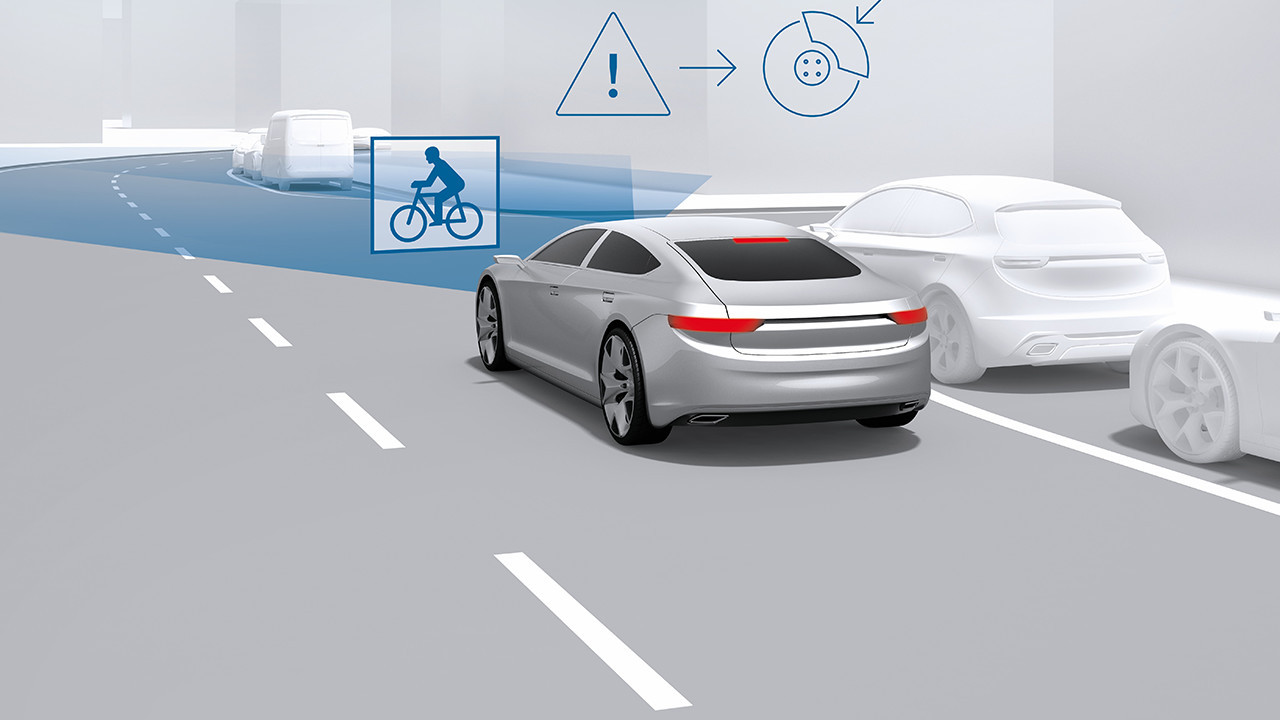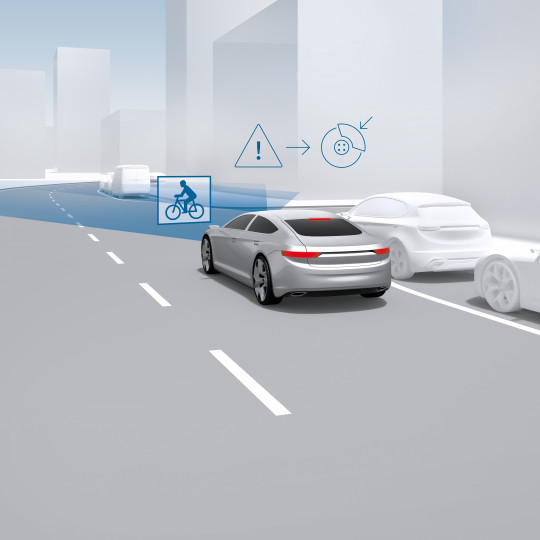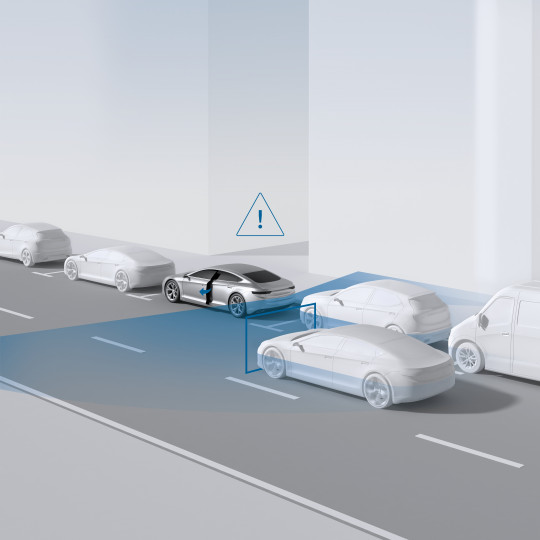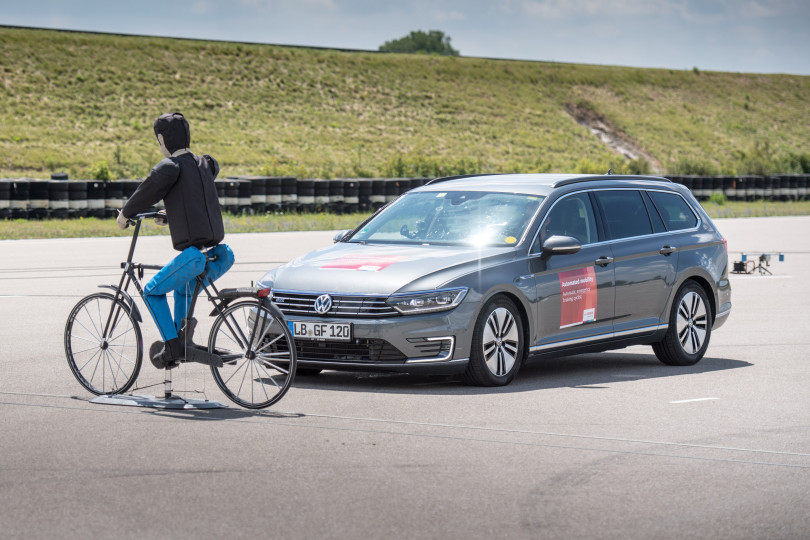Stuttgart, Germany – Another narrow escape: a cyclist appears as if out of nowhere and suddenly crosses the road. Distracted by the search for somewhere to park, the driver is powerless to avert what appears to be an inevitable disaster. Yet Bosch’s new emergency braking system with cyclist detection prevents any serious consequences, automatically bringing the car to a full stop from 40 kph. Everyone makes it through the incident, shaken but unharmed. As soon as the emergency braking system’s radar or video sensor detects an imminent collision, the Bosch iBooster initiates full braking in just 190 milliseconds – less time than it takes to blink twice. “Driver assistance systems are the next step along the path toward accident-free driving,” says Bosch board of management member Dr. Dirk Hoheisel. “These electronic assistants are always vigilant and, in emergencies, they respond more quickly than people can. They provide support just where drivers need it – in busy city traffic.” Emergency braking systems are one of the most useful assistance systems, particularly when it comes to responding to cyclists and pedestrians, the most vulnerable of road users.
More protection where most needed
In Germany, bicycles are involved in one-fourth of all accidents resulting in personal injury. According to the German Federal Statistics Office, 393 people were killed in such accidents in 2016 alone – roughly 12 percent of the country’s total road fatalities. Some two-thirds of these accidents involve a car. Equipping every car in Germany with an emergency braking system that can detect cyclists would prevent almost half (43 percent) the bicycle/motor vehicle accidents that result in personal injury, or at least mitigate their severity. “An emergency braking assistant may reduce braking distance by the few crucial centimeters that can mean the difference between life and death,” says Gerhard Steiger, president of Bosch’s Chassis Systems Control division. The European New Car Assessment Program, or Euro NCAP, has also recognized the importance of emergency braking systems for road safety. Starting in 2018, the consumer protection association’s star rating system will include emergency braking with cyclist detection. Emergency braking systems with pedestrian detection have been part of the rating system since 2016.
Electronic assistants growing in popularity
In light of rising volumes of road traffic, driver assistance systems offer the full package – and hold the key to increased road safety. They keep cars in their lanes, warn of obstacles in the blind spot when changing lanes, provide support for pulling into and out of parking spots, and help maintain following distance, to name just a few examples. Bosch is constantly honing the technology behind these driver assistance systems: sensors supply increasingly precise images of the car’s surroundings, and their interaction with actuators, such as braking and steering, is steadily becoming faster and more efficient. In this way, driver assistance systems are not only preparing the path toward automated driving, but are already delivering stress-free and relaxed driving. No wonder, then, that the spread of electronic assistants is picking up. A Bosch survey found that half of all new cars (52 percent) in Germany have at least one driver assistance system on board. The trend is toward consolidating multiple assistance functions on one sensor, as demonstrated by car exit warning, a new function developed by Bosch.
Radar offers a constant over-the-shoulder view
Bosch’s rear mid-range radar sensors, which monitor lane changes on the freeway, can also keep city drivers from making a dangerous mistake: after parallel parking at the curb, drivers often get out of their cars right away – without looking over their shoulder. This has led to countless cyclists getting painfully up close and personal with car doors as they are knocked unceremoniously to the pavement. But Bosch’s car exit warning can help. It is active for all car doors and warns the occupants – even several minutes after the ignition has been turned off – before they carelessly get out of the vehicle. Mounted to the left and right of the rear of the car, the Bosch sensors monitor traffic. Within a 20-meter radius, the sensors can detect other road users who are approaching from the rear, or who are already to the side or rear of the car, and promptly warn the driver before they open their door.
Mónika Hack
+36 70 510 5516
Mobility Solutions is the largest Bosch Group business sector. In 2016, its sales came to 43.9 billion euros, or 60 percent of total group sales. This makes the Bosch Group one of the leading automotive suppliers. The Mobility Solutions business sector combines the group’s expertise in three mobility domains – automation, electrification, and connectivity – and offers its customers integrated mobility solutions. Its main areas of activity are injection technology and powertrain peripherals for internal-combustion engines, diverse solutions for powertrain electrification, vehicle safety systems, driver-assistance and automated functions, technology for user-friendly infotainment as well as vehicle-to-vehicle and vehicle-to-infrastructure communication, repair-shop concepts, and technology and services for the automotive aftermarket. Bosch is synonymous with important automotive innovations, such as electronic engine management, the ESP® anti-skid system, and common-rail diesel technology.
The Bosch Group is a leading global supplier of technology and services. It employs roughly 390,000 associates worldwide (as of December 31, 2016). The company generated sales of 73.1 billion euros in 2016. Its operations are divided into four business sectors: Mobility Solutions, Industrial Technology, Consumer Goods, and Energy and Building Technology. As a leading IoT company, Bosch offers innovative solutions for smart homes, smart cities, connected mobility, and connected manufacturing. It uses its expertise in sensor technology, software, and services, as well as its own IoT cloud, to offer its customers connected, cross-domain solutions from a single source. The Bosch Group’s strategic objective is to deliver innovations for a connected life. Bosch improves quality of life worldwide with products and services that are innovative and spark enthusiasm. In short, Bosch creates technology that is “Invented for life.” The Bosch Group comprises Robert Bosch GmbH and its roughly 440 subsidiaries and regional companies in some 60 countries. Including sales and service partners, Bosch’s global manufacturing and sales network covers nearly every country in the world. The basis for the company’s future growth is its innovative strength. At 120 locations across the globe, Bosch employs some 59,000 associates in research and development.
Additional information is available online at www.bosch.com, www.iot.bosch.com, www.bosch-press.com, www.twitter.com/BoschPresse, www.bosch.hu







